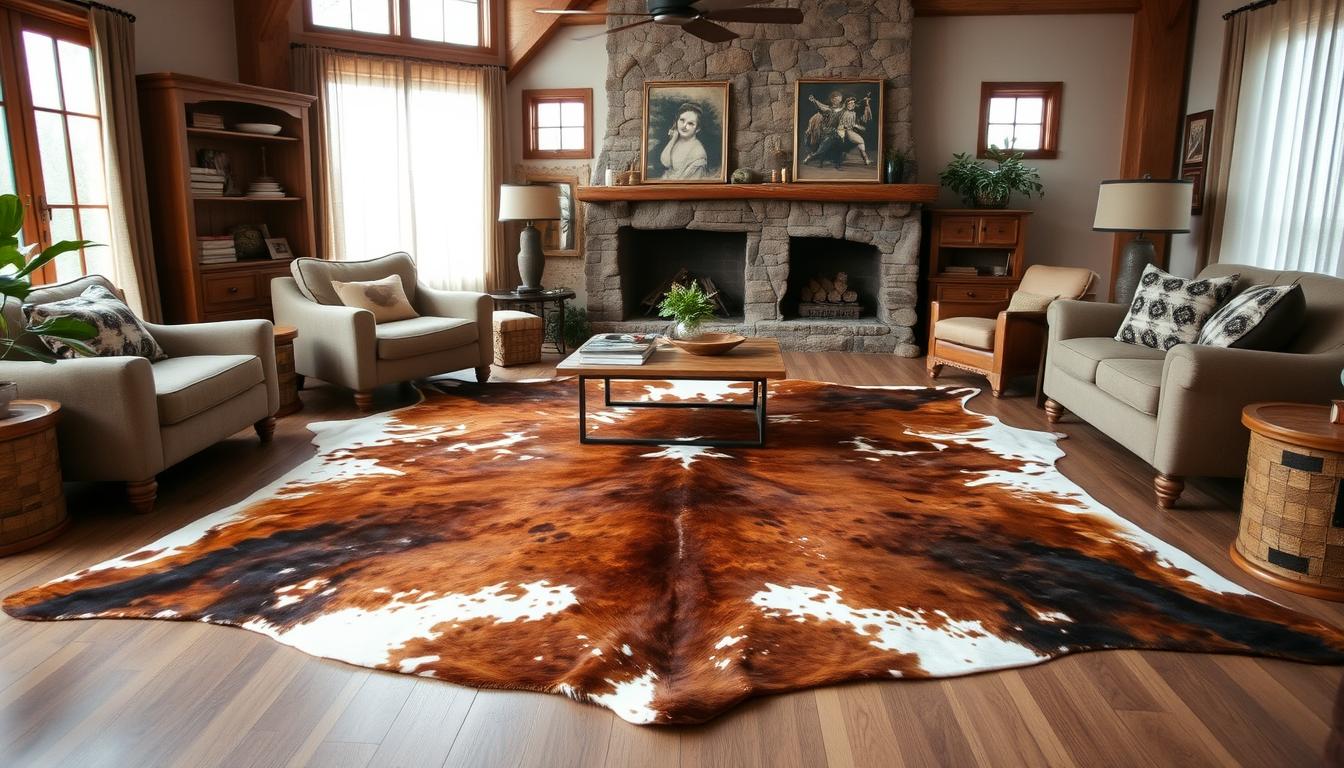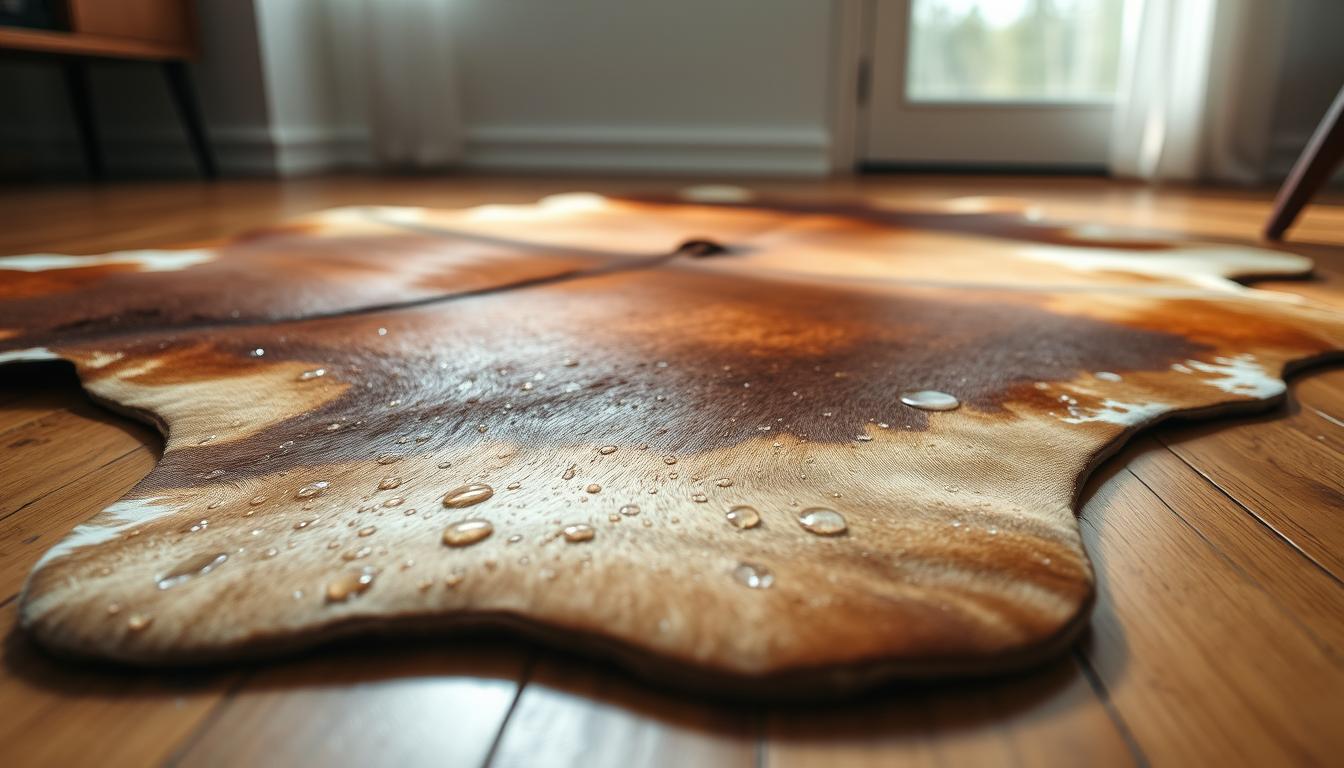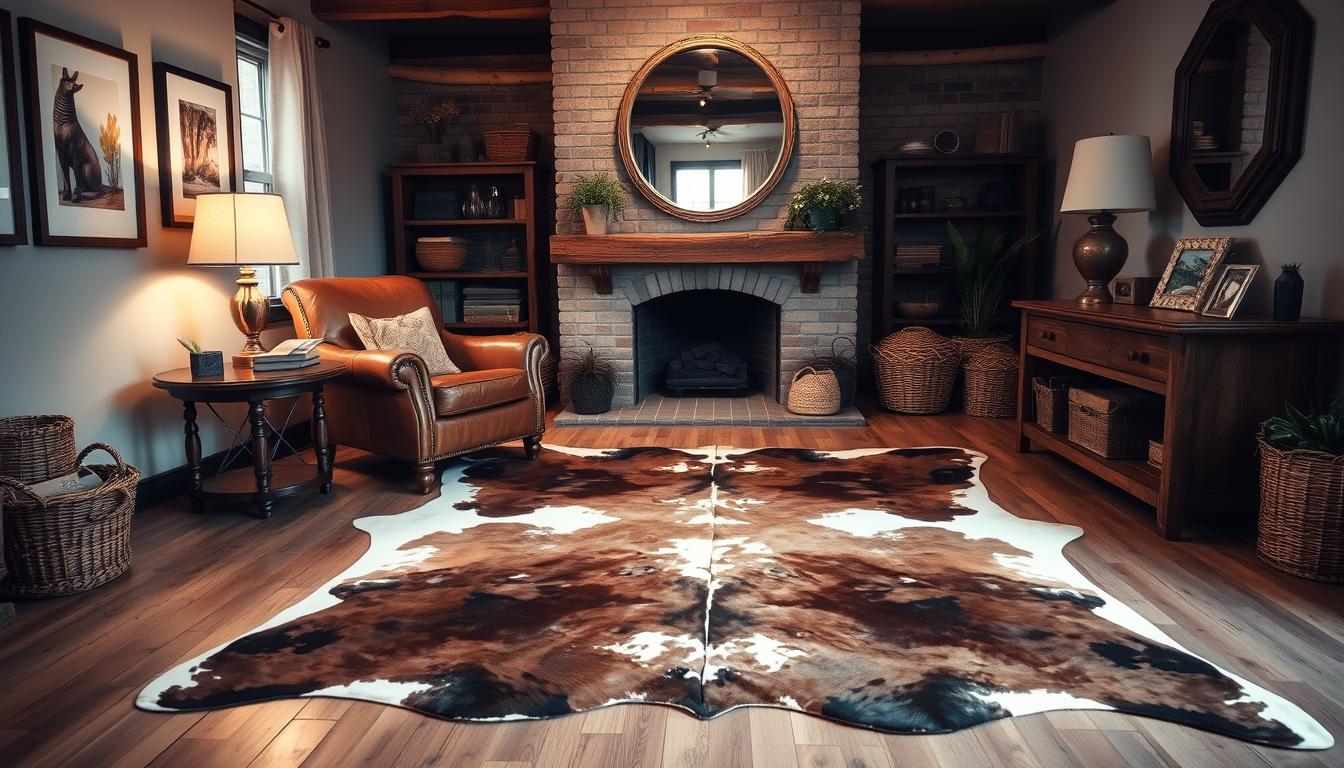
6 Bold Reasons Cowhide Rugs Are Good
Imagine a floor covering that grows more beautiful with age while surviving muddy paws, spilled juice, and constant foot traffic. Why do designers consistently return to natural cowhide rugs decade after decade, even as other trends fade?

These statement pieces have graced interiors from mid-century modern lofts to today’s farmhouse-chic spaces. Unlike synthetic alternatives, they’re crafted to endure 15+ years of use without losing their luster. Their dense fibers naturally repel dust mites and pet dander, making them ideal for allergy sufferers.
Families appreciate how spills bead up instead of soaking in—a quick blot keeps surfaces pristine. Beyond practicality, each hide boasts one-of-a-kind patterns that evolve subtly over time. Sustainable sourcing practices ensure these rugs repurpose materials that would otherwise go to waste.
Ready to discover how these durable masterpieces elevate rooms while standing up to real life? Let’s explore why they remain unmatched in quality and style.
Key Takeaways
- Natural durability lasts 3x longer than standard rugs
- Hypoallergenic properties improve indoor air quality
- Timeless designs adapt to any decor style
- Easy maintenance resists stains and wear
- Ethical sourcing reduces agricultural waste
Introduction: The Timeless Appeal of Cowhide Rugs
Throughout design history, few elements blend function and artistry like cowhide rugs. These natural pieces first gained prominence in 18th-century European estates, where nobles prized their warmth and exotic patterns. Today, they anchor modern spaces with organic texture that synthetic alternatives can’t replicate.
Designers often note how these floor coverings adapt to shifting trends. "A well-chosen hide bridges decades—it works in a 1970s sunken lounge as effortlessly as a minimalist 2020s studio," explains New York stylist Mara Santos. This versatility stems from nature’s unpredictable markings, which create visual interest without overwhelming a room.
Consider how different eras embraced cowhide:
| Era | Design Characteristics | Cowhide Role |
|---|---|---|
| Mid-Century | Clean lines, organic shapes | Added warmth to sleek spaces |
| Industrial | Raw materials, exposed elements | Softened concrete floors |
| Scandinavian | Neutral palettes, hygge | Introduced subtle pattern play |
Unlike mass-produced rugs, each cowhide tells a story through its markings. No two share identical spots or color distribution, making your selection truly one-of-a-kind. They age gracefully, developing a patina that enhances character over years.
In contemporary homes, these pieces serve dual purposes. They define seating areas in open layouts while muffling echoes in rooms with hardwood floors. Their neutral yet dynamic patterns complement bold walls or minimalist decor equally well.
Investing in quality cowhide means acquiring a piece that evolves with your space. As trends cycle, its organic beauty remains relevant—proof that nature’s designs never expire.
The Natural Beauty and Uniqueness of Cowhide Rugs
Nature crafts no duplicates – a truth embodied in every cowhide piece. These organic floor coverings display markings as distinct as human fingerprints, with no two sharing identical swirls or spots.

Discovering Individual Patterns
Three primary pattern types dominate hide selections:
| Design | Color Palette | Visual Impact |
|---|---|---|
| Tricolor | Black, white, brown | Bold contrast for modern spaces |
| Brindle | Streaked earth tones | Subtle movement in neutral rooms |
| Animal Print | Classic black & white | Timeless focal point |
White cowhide rugs showcase delicate speckling that brightens dim corners. Brindle options mimic woodgrain textures, blending seamlessly with rustic elements. Each piece undergoes strict quality checks before receiving its authenticity certificate.
Enhancing Home Aesthetics
Strategic placement transforms these natural artworks into design anchors. Drape a tricolor cowhide under a glass coffee table to energize minimalist layouts. Layer animal print cowhide beneath neutral furniture to create depth without overwhelming senses.
Their irregular shapes soften angular architecture better than geometric carpets. As sunlight shifts across brindle patterns throughout the day, rooms gain dynamic visual rhythm. For detailed styling techniques, consult our natural patterns guide.
These organic masterpieces evolve with your space – their inherent flexibility outlasts fleeting decor trends. Unlike manufactured prints, nature’s imperfections become conversation starters that age like fine art.
Are Cowhide rugs good for Active Home Decor?
Active families need floor solutions that match their pace without sacrificing style. Natural cowhide pieces excel where synthetic alternatives falter, resisting scratches from playful pets and absorbing impact from dropped toys. Their dense fiber structure prevents liquid absorption, letting you wipe away juice or coffee within seconds.
| Challenge | Standard Rug | Cowhide |
|---|---|---|
| Pet Claws | Frayed edges | No visible marks |
| Spills | Staining | Wipe clean |
| Daily Traffic | Flattened fibers | Springs back |
Leather's inherent toughness makes these floor coverings ideal beneath dining tables or in entryways. Unlike woven materials, they don't trap odors from muddy paws or accidental pet messes. For persistent stains, our proper cleaning techniques restore surfaces without harsh chemicals.
Placement flexibility allows rotation between rooms as needs change. Use larger hides to anchor living room seating groups, then shift smaller pieces to bedrooms when redecorating. Their natural patterns disguise minor scuffs better than solid-colored alternatives, maintaining polished appearances through years of use.
Quality, Authenticity, and Ethical Sourcing
Identifying premium materials requires understanding craftsmanship and origin. Reputable suppliers prioritize transparency, offering documentation that traces each hide's journey from ranch to living room.

Ensuring Genuine Cowhide
Authentic pieces display natural imperfections like slight thickness variations and asymmetrical patterns. Look for certification stamps from trusted tanneries—Hudson Hides marks each genuine cowhide with a holographic seal. Avoid synthetic imitations by checking for these traits:
- Distinct hair follicles visible under bright light
- Irregular edges that can't be machine-replicated
- Natural scent resembling clean leather
Choosing a Reputable Dealer
Ethical suppliers source hides as meat industry byproducts, reducing agricultural waste. eCowhides uses vegetable tanning methods that take six months but leave minimal environmental impact. Compare common processing methods:
| Method | Duration | Eco-Friendliness |
|---|---|---|
| Vegetable Tanning | 6 months | Biodegradable materials |
| Chrome Tanning | 2 days | Chemical runoff risks |
Trusted dealers provide detailed origin stories for each piece. Ask about their selection process—top-tier companies reject 40% of raw materials during quality checks. This ensures only durable, good quality cowhide reaches your home.
Caring for Your Cowhide Rug
Preserving your floor covering's natural charm requires simple yet intentional habits. Unlike high-maintenance textiles, these durable pieces thrive with minimal intervention when you follow proper techniques.
Cleaning and Maintenance Tips
Weekly upkeep takes under five minutes with these steps:
- Use a handheld vacuum on low suction
- Always brush in the direction of hair growth
- Rotate the piece quarterly for even wear
For deeper refreshment, professionals recommend:
"Light steam cleaning every 6-12 months lifts embedded particles without compromising natural oils," advises interior designer Clara Bennett.
Preventing Damage and Handling Spills
| Issue | Solution | Tools Needed |
|---|---|---|
| Wine spill | Blot → mild soap → vinegar rinse | Microfiber cloth |
| Mud traces | Air-dry → gentle brush | Soft bristle brush |
| Oil stains | Cornstarch absorption | Baking soda |
Keep your piece vibrant by avoiding direct sunlight and rotating its position seasonally. For stubborn marks, our included guide details organic solutions that protect leather's integrity.
Innovative Ways to Style and Integrate Cowhide Rugs
Transform any space from predictable to extraordinary with cowhide’s chameleon-like adaptability. These statement pieces work equally well in Manhattan lofts and Southern farmhouses, defying outdated stereotypes about rustic limitations.
Modern and Transitional Decor Ideas
Pair white cowhide floor coverings with metallic accents for contemporary edge. Layer zebra print cowhide under lucite furniture to create bold contrast in minimalist rooms. For transitional spaces, blend chocolate white cowhide with linen upholstery and weathered wood tones.
| Design Style | Cowhide Type | Signature Pairing |
|---|---|---|
| Modern | Monochrome | Concrete floors + velvet seating |
| Transitional | Brindle patterns | Mid-century lighting + organic textures |
| Eclectic | Zebra print | Global textiles + vintage finds |
Creative Uses Beyond Floor Coverings
Elevate walls with mounted cowhide art – stretch smaller pieces over wooden frames for gallery-style displays. Drape zebra print cowhide across bench seats as striking upholstery accents. Some designers even line tray ceilings with hides for unexpected drama.
Try these unconventional applications:
- Window valances with fringed edges
- Table runners for organic texture
- Headboard coverings in master suites
Mix multiple hide sizes on living room floors to define zones in open-concept spaces. A large white cowhide anchors conversation areas, while smaller print cowhide pieces add rhythm along pathways. This layered approach works particularly well in loft-style apartments.
Buyer's Guide: Navigating Price and Quality
Selecting the perfect cowhide requires balancing craftsmanship and budget considerations. Origin plays a crucial role in determining both price and quality. Brazilian pieces often command premium rates due to thicker hides and bolder patterns, while European alternatives offer subtle elegance at lower costs.
| Origin | Thickness | Pattern | Price Range |
|---|---|---|---|
| Brazilian | 7-9mm | High contrast | $$$-$$$$ |
| European | 5-7mm | Muted tones | $$-$$$ |
Size variations naturally occur based on animal dimensions. Most pieces span 20-50 square feet - measure your space before purchasing. Larger formats work well under dining sets, while compact sizes accent entryways effectively.
Scrutinize product descriptions for these quality indicators:
- Vegetable-tanned finishes
- Natural edge variations
- Consistent hair density
Cross-reference customer reviews with seller claims. Reputable dealers provide transparent return policies and lifetime craftsmanship guarantees. Avoid vendors using stock photos instead of actual hide images - this often signals inconsistent patterns.
Investing in good quality cowhides ensures decades of service. While initial costs might seem steep, their longevity makes them cost-effective over years of use in active homes.
Conclusion
When choosing home decor that marries resilience with elegance, few options stand the test of time like natural hides. These organic masterpieces withstand spills, pets, and foot traffic while developing richer character with age—a stark contrast to disposable fast-fashion furnishings.
Their hypoallergenic qualities and simple upkeep make them practical for busy households. Unlike synthetic alternatives, every piece tells an ecological story through ethical sourcing practices that repurpose materials responsibly.
For those seeking warmth without sacrificing durability, consider pairing your hide with the plush comfort of wool-blend floor coverings. This layered approach combines texture with functionality, letting you customize spaces to match evolving tastes.
Ultimately, investing in authentic materials means acquiring heirloom-quality pieces that adapt to your lifestyle. Their inherent versatility bridges design eras, proving that true style needs no expiration date.
FAQ
How durable are cowhide floor coverings in homes with pets?
These natural hides are highly resilient, making them ideal for active spaces. Their dense fibers resist scratches and stains, while the tanning process adds a protective layer. For pet owners, quick cleanup of spills or accidents with a damp cloth helps maintain their longevity.
Can tricolor or brindle patterns clash with modern decor styles?
Not at all! Unique markings like brindle or tricolor cowhides add texture without overwhelming minimalist designs. Pair them with neutral furniture or metallic accents to balance bold patterns. Brands like Bovino Designs specialize in hides that complement contemporary aesthetics.
Are these rugs ethically sourced from the meat industry?
Reputable dealers ensure hides are byproducts of the meat industry, reducing waste. Look for certifications like the Leather Working Group or suppliers like Dakota Fields, which prioritize ethical practices. Avoid vendors unable to trace their sourcing origins.
What’s the best way to clean spills on a white cowhide rug?
Blot spills immediately with a dry cloth, then lightly dab with a damp cloth and mild soap. Avoid harsh cleaning products, which can strip natural oils. For stubborn stains, professional services like FibreCare specialize in restoring hides without damaging delicate patterns.
Do cowhides work as wall art or furniture accents?
Absolutely! Designers often use them as statement wall hangings or draped over benches. West Elm and CB2 showcase creative applications, like layering smaller goat hides on shelves or framing brindle cuts for gallery walls.
How do I verify if a rug is genuine cowhide?
Authentic pieces have irregular markings, slight texture variations, and a leather smell. Fake alternatives like printed polyester lack natural imperfections. Trusted brands such as Kyle Bunting or The Cowhide Store provide authenticity guarantees and detailed product reviews.
Are zebra-print cowhides considered animal-friendly?
Zebra prints are typically dyed or printed on genuine cowhide—not from exotic animals. Ensure the base material is ethically sourced cowhide, and avoid sellers offering real exotic skins, which raise ethical concerns.
Can I use a cowhide rug in high-humidity areas like bathrooms?
It’s not recommended. Excess moisture can weaken fibers over time. Instead, opt for synthetic alternatives in humid spaces. For moisture-prone rooms, brands like Lorena Canals offer washable options mimicking hide patterns.









